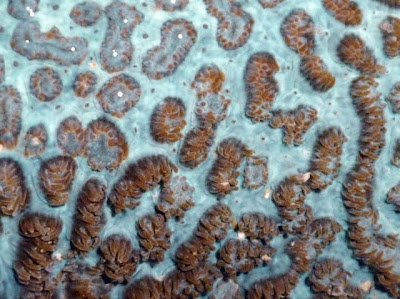On Sunday afternoon, we visited another submerged reef for the first time! It is called South Cyrene. Aye, isn't Cyrene Reef the reef that we have been visiting regularly? Cyrene Reefs are actually composed of three reefs: Terumbu Pandan (the Cyrene Reef we have been visiting all along), South Cyrene and Pandan Beacon.
We arrived when the tide was still a bit high and the bright orange beacon of South Cyrene made navigation easier for us to locate this emerging reef.
Landing on this shore for our first time, I immediately checked out the most and only prominent structure: the South Cyrene beacon.
What can we find around this beacon? Are there marine life?
Yes! Among the thick bloom of the sargassum seaweed, I found a nice patch that is not blocked by the seaweed. It has a couple of huge Giant carpet anemones (Stichodactyla gigantea) and some corals.
Among the rocks at the base of the beacon, I was thrilled to find this charismatic Arabian cowrie (Cypraea arabica) tucked within a crevice.
I was flipping some rocks to check out what lies beneath and viola! Another arabian cowrie!
Around that patch, I also found the Black-margined nudibranch (Glossodoris atromarginata). This is the only nudibranch I came across that day.
There was also this really huge Giant top shell snail (Trochus niloticus) which has signs of nice black bands on the shell.
The hard corals in this shore are not as abundant as many of our other southern shores. They are quite sparsely spaced out too.
An interesting fact we noticed was that most of the Pore corals (Porites sp.) had white marks that are possibly caused by feeding parrot fishes.
There were also some patches of the Leathery soft corals (Family Alcyoniidae) on this reef.
At some parts of the reef, one can still find colourful assortment of marine life such as soft corals and sponges.
The most abundant sea cucumber at South Cyrene must be the Long black sea cucumber (Holothuria leucospilota). They are very common on this shore.
I came across about 4-5 of another species of sea cucumber. This is the Stonefish sea cucumber (Actinopyga lecanora). They are called stonefish sea cucumber due to the fact that they are usually found wedged among the stones like this one.
Another echinoderm I stumbled upon will be this tiny brittle star.
Anemone wise, there were quite a good variety of these Frilly sea anemones (Phymanthus sp.). Those I saw were no longer bleaching.
This Spider conch (Lambis lambis) was detected by me when it moved. Otherwise, I wouldn't have notice it as its upper side (not shown in this photo) looks like a rock and is very well camouflaged with the environment.
Another distinguishing feature of South Cyrene will be the numerous Giant reef worms (Eunice aphroditois) snatching a piece of the sargassum seaweed before they quickly retract back into their burrows.
During sunset, the octopuses came out to play! Quite a number of them were seen roaming the reef towards the end of our trip.
Last but not least, here is a colony of blue coloured coral that I have no idea what it is.
Here is a close up of the corallites which are quite far apart from each other. Would be nice if someone can shed some light on its identity.
As usual, the sunset marked the end of the trip. There were no seagrasses at all on this reef which Siti was looking for. Though the shore is not as rich and special as Terumbu Pandan, or the usual Cyrene Reef that we have been visiting, it is always good to check out a new reef to know what lies there.
More photos of the trip here: http://www.flickr.com/photos/koksheng/archives/date-posted/2010/10/12/
Tuesday, October 12, 2010
Virgin trip to South Cyrene Reef
Subscribe to:
Post Comments (Atom)


























No comments:
Post a Comment